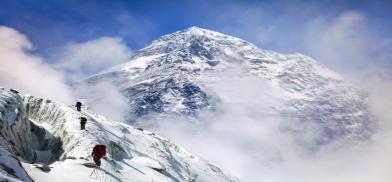Everest buzzing: Pandemic not a concern for aspiring summiteers
While the world grapples with a resurgence of Covid-19, for those hoping to summit the globe’s highest peak, Mount Everest, the pandemic is not a cause for concern any more

While the world grapples with a resurgence of Covid-19, for those hoping to summit the globe’s highest peak, Mount Everest, the pandemic is not a cause for concern any more. And the Everest region is humming with tourist activities after a painful 2020, according to The Kathmandu Post.
Yaks and ponies are transporting supplies on their backs up to the base camp at 5,380 metres from Lukla’s Tenzing Hillary Airport, a small landing strip carved into the side of a mountain at 2,860 metres where expedition members usually fly into.
Icefall doctors, the a dedicated team of high-altitude experts who fix the ropes and ladders up to Camp 2 to make the path easy for climbers, are already on their jobs. Hundreds of porters, high-altitude workers and staff at hotels and restaurants who had been laid off have got their jobs back.
Expedition outfitters, restaurants and hotels and logistic suppliers are back in business, with the 2021 spring Mount Everest climbing season now underway.
Although the actual climb towards the summit takes place in May, expeditionists get to the mountain as early as March to acclimatise to the high altitude.
“This year, even in the midst of the pandemic, the climber numbers are expected to reach near-record levels,” said Ang Tshering Sherpa, former president of Nepal Mountaineering Association.
Reaching the highest point on earth at 8,848.86 metres (29,031.69 feet) cost $35,000 to $90,000 per person depending on the extent of support the climber needs in terms of guides and supplies. This amount includes the climbing permit cost of $11,000.
According to Nepal's Department of Tourism, the state agency that issues the climbing permits, 244 climbers –193 men and 51 women – have already been given permits to climb Everest as of Friday.
The attraction of Everest is good economics not only for the workers and businesses but also for the government, with the tourism department so far collecting $2.64 million as fees for Everest permits.
“Given the trend, the number of climbers seeking Everest permits could rise to 350, or near the 2019 level,” said Mira Acharya, director at the department. “The number is better than expected in this current situation.”
In 2019, Nepal had issued Everest permits to 381 climbers, the record number so far.
According to Acharya, potential climbers have been complaining about the difficulties of air connectivity to Nepal as more countries are enforcing lockdowns and restriction measures, the report said.
Nepal too has employed extra measures. The Department of Tourism has set up a health camp with two doctors—a first—at Everest base camp.
Some of the climbers are eyeing records of all sorts, according to sources within the mountaineering industry.
Zhang Hong, 46, from Sichuan, China aims to become the first blind person from Asia and third in the world to climb Everest.
China has closed Everest to expeditions this year too.
“He will be assisted by four climbing guides directly,” said Dawa Steven Sherpa, CEO of Asian Trekking. “The Chinese climber is confident.”
Industry insiders say that Colin O'Brady plans to climb Everest and the 8,516-metre Lhotse, the world’s fourth-highest peak, in one go.
The summit to the two peaks diverges at the South Col situated at 7,906 metres.
This double-summit feat was achieved by American guide Michael Horst on May 14, 2011. Horst climbed Everest and Lhotse in under 21 hours.
Spanish climber Kílian Jornet plans to explore the dangerously difficult West Ridge of Everest without supplemental oxygen. Willi Unsoeld and Tom Hornbein, two members of an American team, had climbed Everest using the West Ridge in 1963, a decade after Tenzing Norgay and Edmund Hillary had reached Everest by the South Col route.
Arjun Vajpai of India, who had climbed Everest in 2010 at the age of 16, becoming the youngest Indian climber to do so, is back on the mountain after 11 years and this time, he is climbing without the supplemental oxygen.
“A dream which I had since the first time I stood on top of Everest as a 16 year old! [sic] I head back to Mt. Everest after 11 long years but this time without oxygen!” he wrote on his Facebook page.
A Qatari woman is on a quest to complete the Explorers Grand Slam—reaching the summits of the seven highest mountains in all seven continents and the two poles.
After reaching the North Pole, climbing the 6,959-metre (22,831 feet) Mount Aconcagua in South America and the 5,895-metre (19,340 feet) Mount Kilimanjaro in Africa, Sheikha Asma Al Thani’s sight is now set on Everest. If she climbs Everest, she will also be the first woman from her country to climb the mountain and 472nd from the world, from the Nepal side.
Another 16-member royal Bahrain team, who controversially arrived with 2,000 doses of Covid-19 vaccines for the people of a Gorkha village, is also acclimatising in the Everest region.
According to the Guinness World Records, the site that records ultimate record-breaking facts and achievements, the most number of people to reach the peak of Everest on a single day is 354, with 212 climbers from the Nepal side, as recorded on 23 May 2019. This is considerably more than the previous record of 266 people, set on 19 May 2013.
A total of 6,507 mountaineers have climbed Everest from the Nepal side.
Overall, in 2019, 11 people died on Everest, 10 from the Nepal side.
“There are tragedies on Everest every year, but it doesn't seem to have deterred adventure enthusiasts,” said Sherpa, the former president of Nepal Mountaineering Association.








Post a Comment